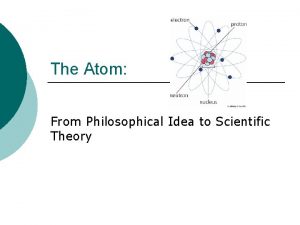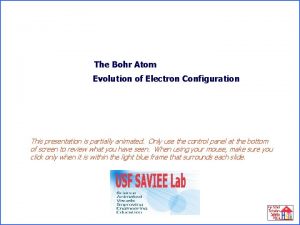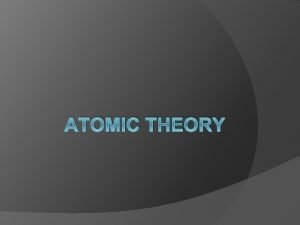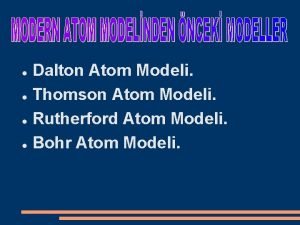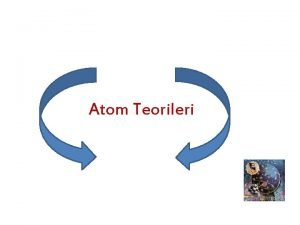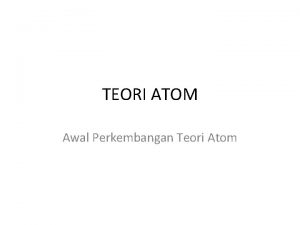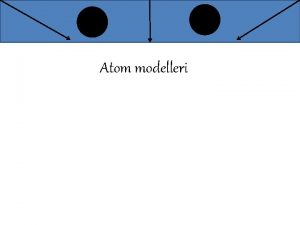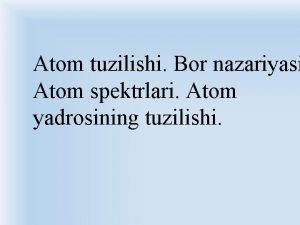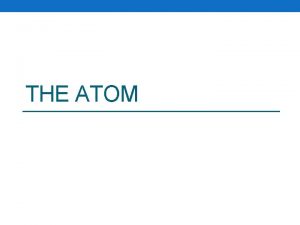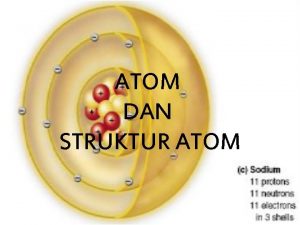The Development of the Theory on the Atom















- Slides: 15

The Development of the Theory on the Atom Democritus to Bohr

WATCH How small is an atom?

450 BC Greek - Democritus 1. Atom was indivisible 2. Theorized the existence of the atom 3. Also, theorized that there were just four 'elements' fire, water, air,

1803 John Dalton 1. Atom was indivisible. 2. All elements are composed of atoms. 3. The same atoms for one element are exactly alike. 4. Atoms are neither created nor destroyed in a chemical reaction. 5. In a chemical reaction, atoms are separated, combined, or rearranged.

1897 J. J. Thomson �discovered the electron using the cathode ray tube. �determined that the electron was smaller than a hydrogen atom. �Knew the atom was neutral and the electron was negative, so there must be positive material with a lot more mass.

J. J. THOMSON �Said the atom was a positive pudding-like material throughout which negatively charged electrons were scattered - Plum Pudding or Chocolate Chip Cookie Model

LASERDISC:

1909 Ernest Rutherford 1. Did a famous gold foil experiment (the alpha scattering experiment). 2. Calculated that the atom was mostly empty space through which electrons move. 3. Concluded that the atom has a small, dense, positively charged, centrally-located nucleus surrounded by negatively charged electrons.

1919 Ernest Rutherford 1. Called the positive particles protons.

1932 Rutherford and James Chadwick �showed the nucleus also had neutrons. �The neutron was basically equal in mass to the proton but had no electrical charge.

1914 Neils Bohr Concluded that electrons moved around the nucleus in definite orbits or energy levels.

THE DIVISIBLE ATOM – REVISITING DALTON 1. 2. 3. 4. 5. Atom was indivisible. FALSE All elements are composed of atoms. TRUE The same atoms for one element are exactly alike. FALSE Atoms are neither created or destroyed in a chemical reaction. TRUE In a chemical reaction, atoms are separated, combined, or rearranged.

ATOMIC THEORY THE ATOM IS �is spherically shaped. �with a dense, centrally located, positive nucleus containing protons and neutrons. �surrounded by one or more negatively charged electrons in an electron cloud. �Most of the atom’s volume consists of fast moving electrons traveling through the empty space that surrounds the

ATOMIC THEORY �Electrons are held within the atom by an attraction to the positive nucleus. �The nucleus has neutral neutrons and positive protons and 99. 9% of the mass. �Since atoms are electrically neutral, the number of protons must equal the number of electrons.

THE THEORIES THROUGH TIME
 The structure of the atom section 2 defining the atom
The structure of the atom section 2 defining the atom Teori atom modern
Teori atom modern The atom from philosophical idea to scientific theory
The atom from philosophical idea to scientific theory Electrons in atoms section 2 quantum theory and the atom
Electrons in atoms section 2 quantum theory and the atom Electrons in atoms section 2 quantum theory and the atom
Electrons in atoms section 2 quantum theory and the atom Bohr configuration
Bohr configuration Whats the atomic theory
Whats the atomic theory History of community development in south africa
History of community development in south africa Development that ended much development crossword
Development that ended much development crossword Pattern development sheet metal
Pattern development sheet metal Hát kết hợp bộ gõ cơ thể
Hát kết hợp bộ gõ cơ thể Slidetodoc
Slidetodoc Bổ thể
Bổ thể Tỉ lệ cơ thể trẻ em
Tỉ lệ cơ thể trẻ em Voi kéo gỗ như thế nào
Voi kéo gỗ như thế nào Tư thế worm breton
Tư thế worm breton


